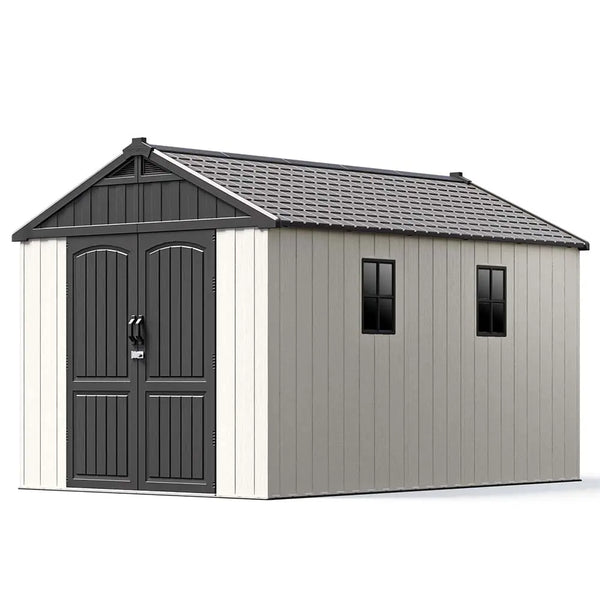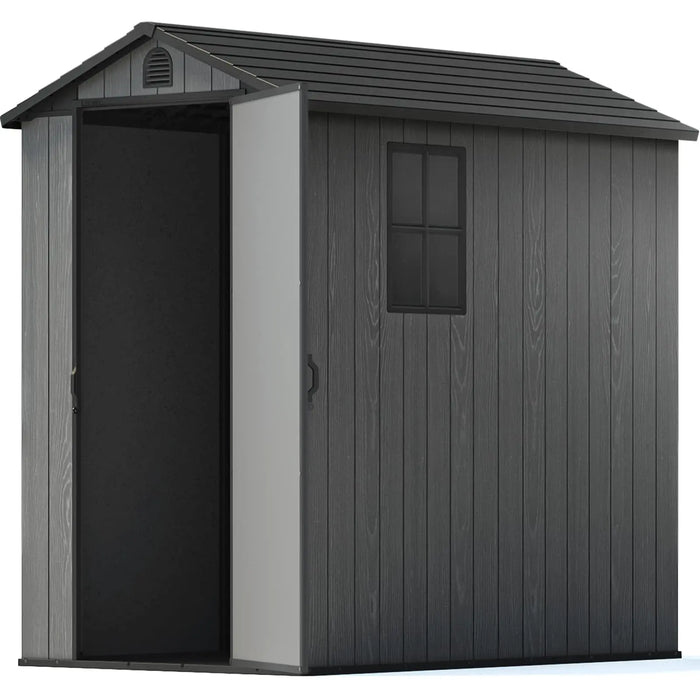We’ve all had situations when our sheds are uneven, and they don’t look right. If you have a shed that seems to be sinking or which is turning to the right/left a bit too much, it’s a good idea to learn how to lift a shed and level it properly. We’ve created a small guide on how to raise a shed off the ground and level it properly. Don’t worry; the guide is simple and easy to follow, so it’s great for beginners and experts alike!
Table of Contents:[hide]
Why Do You Need to Raise a Shed and Level It?
Before you learn how to lift a shed or buy a shed jack, it’s important to understand why you should raise a shed in the first place. Different situations will require shed leveling, depending on how the shed looks. The most common reasons include:
Uneven shed base
One of the reasons you might be dealing with is you have an uneven ground shed base, which means the entire shed is not leveled properly. You will need to do a proper shed lift that will help solve those problems.
Shed windows and doors are not even
Sometimes, you will notice that your shed’s doors and windows are not even. When that happens, you will need to raise the shed. That will level everything and prevent any damage to the doors or windows, eventually.
The shed is noticeably leaning to the left/right
A very common situation is that the shed is leaning either to the right or towards the left side. These things happen when the foundation has water damage. If that’s the case, lifting the shed is crucial and something you have to do right away. If you have water pooling under the shed, that suggests the shed is not leveled, so learning how to level shed becomes extremely important.
Base or wall gaps
When the shed is not leveled, you will have base and wall gaps. These get worse if you’re not leveling the shed quickly. And even then, during the lifting process, you still need to pay attention to them, to avoid any further gaps.
Tools and Materials Needed
Once you know the reasons why you must level the shed, it’s a good idea to prepare the list of materials and tools you need. When you try to learn how to level a shedalready built, certain tools will be extremely important to use!
- The best jack to lift a shed will help you lift the shed quickly and without any concerns.
- In order to keep the shed’s new height, you need supportive blocks and beams.
- Focus on safety, buy high quality protective equipment and some safety goggles, they are ideal when learning how to jack up a shed.
- A hammer can be used to re-adjust blocks and beams.
- A leveling tool or a shed leveling kit will be helpful as well.
Keep it as empty as possible since it will make leveling a shed a much simpler experience. Other tools could include measuring tape, a pencil, and maybe even some nails and screws, depending on any adjustments you need to make.
How to Raise a Shed?
Step 1: Assess The Situation
The first thing you want to do is to see how bad of a situation you are dealing with. Is the shed tilting? Do you have clear signs of foundational damage? Are the doors and windows not closing properly? Perform measurements and see how much you need to lift your shed. You’ll have a properly leveled, raised shed in the end, but you want to perform all measurements properly. You want to do a proper shed lift, and one that will improve the functionality, without damaging the shed at all.
Step 2: Gather Your Tools
Now that you know the extent of the situation, you can start planning how to level a storage shed properly. Gather your tools, more specifically the shed jack, safety equipment, beams and block (made out of concrete or wood), and also ask a few friends for help. They can also offer guidance and let you know if you need to be leveling a shed more or if you’re at the right level.
Step 3: Lift It Up
Once you reach this point, make sure that you find the right jack positioning. What we recommend you to do is:
- Search for a solid part of the frame, be it a beam or a corner. The idea is to have a solid part of your shed that can be lifted without any damage.
- Once you place the shed, you can do a few, minor tests to try and increase the shed level. In general, the best approach is to lift the shed only a few inches at a time.
- As you use the shed lift jacks, you want to stop every couple of inches to check for stability. If the shed is stable, you can go ahead and raise it a bit more.
- Check with the level and see if the shed is leveled properly or not. Do that as you progress because it will give you a good idea of where you are and how much you need to raise the shed, if at all.
Step 4: Support And Level
During the shed lifting process, you want to add beams and blocks under it slowly. Their role is to support and distribute the weight evenly. As we mentioned earlier, you want to use the level as a way to check the progress and see if you need to make any other changes. It’s a process that will take multiple tries to get it right. Don’t rush, and instead, take a short break after each lifting increment. That will allow you to raise the shed without any damage.
Step 5: Secure The New Position
Check with the level multiple times, and if you see any differences or issues, make changes slowly. However, once you reach the desired position, you want to secure it. A lot of the time, reinforcing the foundation will do the trick. You can also use a gravel bed or various piers made out of concrete. Work on the foundation, and after the shed foundation repair is finished, you can lower the shed onto the new foundation. Again, lower it slowly because it will make the process easier. And that’s how to raise a shed off the ground, then secure it into position.

- Featuring a one-piece panel design and plug-in structure, it's remarkably easy to assemble
- Crafted for Superior Protection & Security
- Designed for Stability and Sustainability
How to Tell If Your Shed Is Not Level?
Step 1: Visual Inspection
If you do a visual inspection, that might tell you whether the shed is leveled or not. Check if there are gaps between the ground and the bottom of the shed. You can also try to open and close the windows/doors. If the shed is leveled, they should be working without a hitch. It’s also a good idea to look for any structural bends or cracks; those can also be a sign the shed is not leveled.
Step 2: Use A Level
Using a level is the best approach because it gives an accurate insight into how leveled the shed truly is. Check for variations on the side of the shed because that’s where you can encounter a lot of issues. Use the level both on the floor and the shed walls, too.
Step 3: Check For Structural Damage
Structural damage can be a factor behind a shed being unleveled. The best thing you can do is to assess the structure and see if there are damaged beams or panels. Those need to be repaired or replaced. It’s also fair to check for any water damage since that can further affect the structure and cause inherent damage in the long term.
How to Straighten a Leaning Shed?
Step 1: Determine The Cause
Why is your shed leaning? Normally, it’s either due to foundational damage or the ground under it might be eroded. If the shed is made out of wood, you may want to check for any signs of rotting as well.
Step 2: Stabilize The Base
Once you know the cause, you want to perform the necessary repairs. If any wooden beams are rotten, you need to replace them. Additionally, you can treat the new beams with chemicals that will deter pests from approaching. In case the area was eroded, remove all the water and redo/repair the foundation accordingly.
Step 3: Straighten And Support
Now, you want to go through the process of using the shed jack and slowly lift the shed. Use beams to support the weight and ensure everything is leveled. Anchoring the shed to the ground will also help if you choose to maintain the shed position.
Can You Raise a Shed By Hand?
When you’re wondering how to level a storage shed, you might also want to know if you can raise a shed by hand, and the answer is no. You will need dedicated equipment like shed jacks, maybe a shed leveling kit, etc. it’s a multi-person job, and it requires a lot of precision. You are working with a lot of weight, and if it’s not handled properly, it can lead to accidents, shed damage, and other problems.
How can you raise a shed:
- A very common method is to dig holes right under the shed, so the shed jack can be placed there. And then all you have to do is to gradually increase the jack height so the shed can be leveled. Adding beams under the shed to ensure it all stays leveled is crucial here.
- Another lifting method would involve using a shed leveling kit, which uses a jack that gets added right under the shed base, and which will allow you to keep the base intact. Usually, a shed leveling kit should come with either one or two shed jacks to lift the shed enough.
- Manually trying to raise the shed could be an option only if the shed is small. But the problem is that without a shed jack, your hands can be easily damaged. And even for a smaller shed, this might not be possible. That’s why it’s incredibly important to raise the shed only by using specialized equipment.
- Excavators can also be used to raise a shed and then you can add beams under it to level everything. The problem with excavators is that they can lead to shed damage, so they are not the best option all the time. But they could work in the case of a larger shed.
Conclusion
Figuring out how to level a shed and finalize this task properly can be a very difficult, challenging thing. Not only must you perform the right measurements, but you also need to have the right tools, perform visual inspection, and have a team with you that will help stabilize the shed. Even if you’re leveling a small shed, you still need a couple of other people to add beams under the shed.
That’s why you need to identify all you need, follow these guidelines, and you won’t have a problem getting the best results. We guarantee that once you follow these tips, leveling your shed will be a much easier process.
If you’re looking to buy a shed and install it with ease, we recommend giving the Patiowell sheds a try. These sheds are very easy to install, durable and you have a variety of designs to choose from. Plus, these sheds are easy to level, and they offer plenty of customization options. Give them a try today if you want an excellent, high quality shed for your garden!

- Featuring a one-piece panel design and plug-in structure, it's remarkably easy to assemble
- With well-designed vents to ensure air circulation, it is moisture and mildew resistant.
- The sloped roof design cleverly incorporates easy drainage
Shed Lifting FAQs
What kind of shed jack should I use?
Any type of jack will work, technically, if it supports the shed’s weight. You always want to double-check and see if the jack will support the weight or not. Because if it can’t do that, you will need to purchase a new one. We highly recommend going with a professional shed jack!
Do you really need beams and blocks when lifting a shed?
Whether you want to do a shed foundation repair or you want to lift your shed, these blocks and beams are a must-have. That’s why it’s a good idea to perform measurements and buy as many of them as you need.
What if there’s water damage in your shed?
Before you attempt to learn how to raise a shed or lift it, you need to remove the water damage. Once you do that, check for any signs of shed damage and repair the shed. Only then can you continue with raising and leveling your shed.
Diana Mason
Hi there! I’m Diana Mason, the chief editor of Patiowell brand. With over 15 years of diving deep into the world of outdoor furniture, I’ve developed a keen eye for what makes outdoor spaces truly special. I love sharing tips and inspiration to help you create your perfect backyard retreat. Our blog is a reflection of my passion and expertise, featuring only the best pieces that I personally vouch for. Thanks for stopping by—I can't wait to help you transform your outdoor living space!








Leave a comment
All comments are moderated before being published.
This site is protected by hCaptcha and the hCaptcha Privacy Policy and Terms of Service apply.